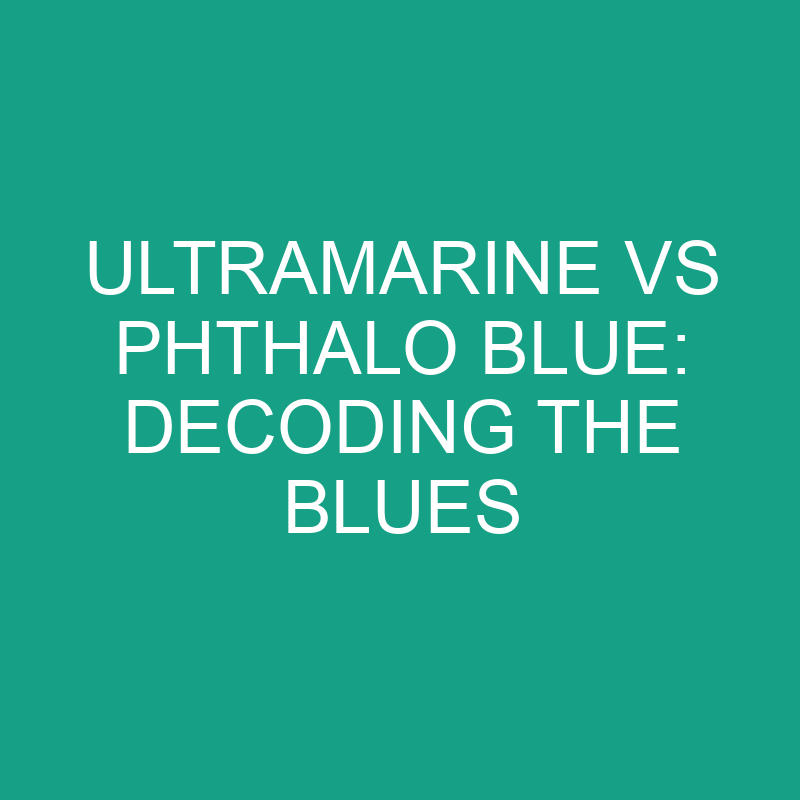In the vast palette of colors available to artists, blues hold a special place for their depth, versatility, and emotional resonance. Among the myriad blues, Ultramarine and Phthalo Blue stand out as stalwarts, each bringing its unique characteristics to the canvas. Let’s delve into the fascinating world of Ultramarine and Phthalo Blue, unraveling their origins, properties, and impact on art.
Post Contents
Ultramarine Blue: The Essence of Luxury
Origins:
Ultramarine blue has a rich history dating back to the Middle Ages. Derived from lapis lazuli, a semiprecious stone, the pigment was a symbol of luxury and wealth. Its name itself, “Ultramarine,” translates to “beyond the sea” in Latin, reflecting the arduous journey of the stone from Afghanistan, where it was mined, to Europe.
Chemical Composition:
The chemical composition of Ultramarine involves complex mineral elements, primarily derived from lapis lazuli. The process of extracting the pigment from the stone was laborious, making Ultramarine one of the most expensive pigments in history.
Characteristics:
- Richness: Ultramarine is celebrated for its deep and rich blue hue. It possesses an intrinsic warmth that sets it apart from other blues.
- Opacity: It is a semi-transparent pigment with good covering power. While not entirely transparent, it allows some light to pass through, imparting a sense of depth to paintings.
- Granulation: Ultramarine tends to granulate, creating a textured effect on the surface of the canvas. This granulation adds character to washes and subtle nuances to paintings.
- Color Shift: Ultramarine exhibits a subtle color shift as it dries, often deepening in intensity. This characteristic can be utilized for creating layered and nuanced artworks.
Applications:
Ultramarine blue finds its place in various artistic genres, from classical oil painting to contemporary watercolor. It is a staple in palettes for rendering skies, seascapes, and atmospheric effects. Its historic significance and unmatched richness make it a sought-after pigment for artists seeking a touch of tradition in their work.
Phthalo Blue: The Modern Marvel
Origins:
Phthalo Blue, short for Phthalocyanine Blue, is a modern synthetic pigment that emerged in the 20th century. Its creation marked a significant departure from traditional pigments, offering artists a more affordable and stable alternative.
Chemical Composition:
Phthalo Blue belongs to the phthalocyanine family of pigments. The synthetic production of this pigment results in a more consistent and controllable color compared to natural pigments like Ultramarine.
Characteristics:
- Intensity: Phthalo Blue is renowned for its intense and vibrant color. It is often described as a “clean” blue, lacking the subtle warmth found in Ultramarine.
- Transparency: It is highly transparent, allowing light to pass through with minimal diffusion. This transparency makes it an excellent choice for glazing techniques.
- Staining: Phthalo Blue has a strong staining property, meaning it tends to adhere strongly to surfaces. Artists need to be mindful of its staining effect, especially in watercolor and acrylic painting.
- Mixing: It is a powerful mixer, capable of creating a wide range of greens when mixed with yellows. Its versatility makes it a favorite for artists exploring color harmonies.
Applications:
Phthalo Blue has found widespread use in contemporary art due to its vibrancy and versatility. It is a popular choice for acrylic and oil painters seeking a bold and striking blue. Its staining property can be an asset or a challenge, depending on the desired effect, and it is often employed in abstract and modern compositions.
Comparative Analysis: Ultramarine vs. Phthalo Blue
1. Color Characteristics:
- Ultramarine: Deep and warm with a subtle red undertone.
- Phthalo Blue: Intense and vibrant with a cooler, almost electric, hue.
2. Opacity and Transparency:
- Ultramarine: Semi-transparent with good covering power.
- Phthalo Blue: Highly transparent, making it ideal for glazes.
3. Granulation:
- Ultramarine: Exhibits granulation, adding texture to washes.
- Phthalo Blue: Generally smooth without granulation.
4. Staining Property:
- Ultramarine: Less staining compared to Phthalo Blue.
- Phthalo Blue: Strong staining effect, adhering firmly to surfaces.
5. Cost:
- Ultramarine: Historically expensive, especially when derived from lapis lazuli.
- Phthalo Blue: Economical and widely accessible due to synthetic production.
6. Versatility:
- Ultramarine: Versatile but often associated with traditional styles.
- Phthalo Blue: Highly versatile and favored in contemporary and abstract art.
Choosing Between Ultramarine and Phthalo Blue: A Matter of Style
The choice between Ultramarine and Phthalo Blue ultimately boils down to artistic preference, style, and the desired visual impact. Traditionalists and those seeking a touch of historical richness might lean towards Ultramarine for its warmth and granulating texture. On the other hand, artists exploring contemporary or abstract styles might find the intense vibrancy and staining power of Phthalo Blue more in line with their creative vision.
As with any artistic endeavor, experimenting with both pigments and understanding their nuances allows artists to expand their palette and harness the expressive potential of these captivating blues. Whether it’s the timeless elegance of Ultramarine or the modern dynamism of Phthalo Blue, each pigment brings its own magic to the canvas, contributing to the kaleidoscope of colors that define the ever-evolving world of art.
